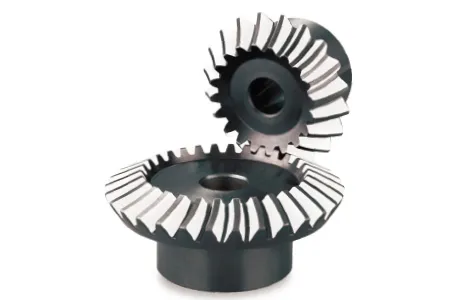Hard Edges and Smooth Turns: How Smart Materials and Gear Design Power Modern Machinery?

Power in the world of mechanical engineering is not all about brute force but about direction, control and durability. Whether it is the robotic arms, industrial drills, or high-speed turbines, the unrecognized heroes of such systems are the precision-engineered parts that are made using the strongest materials.
Among these are two cornerstones of mechanical design: the bevel gear, which masterfully redirects motion, and tungsten steel products, known for their unmatched hardness and resilience. The combination of these two innovations creates the core of most of the modern machines, as well as, guarantees their smooth functioning and high endurance.
In this article, we will discuss the synergy between advanced materials and intelligent gear geometry to produce systems that are capable of high torque, low energy loss, and in high operating stresses. It is a journey into the unsung heroes of the industries.
Bevel Gear Basics: Changing Direction Without Losing Power
A bevel gear is a type of mechanical gear with conically shaped teeth, typically used to transmit motion between intersecting shafts—often at a 90-degree angle. They have critical use in applications where there is a need to change the direction of the force in a manner that maintains the torque and the speed.
Bevel gears come in several variations, including straight, spiral, and hypoid types. Straight bevel gears are simpler and cost-effective but produce more noise and stress during operation. Spiral bevel gears, on the other hand, have curved teeth that offer smoother engagement, reduced vibration, and better load distribution. Hypoid bevel gears are used when the shaft axes don’t intersect—offering even more flexibility in mechanical design.
The efficiency of a bevel gear depends on several factors: tooth geometry, surface finish, and material strength. In high performance applications such as aerospace, robotics or automotive power train, any imperfection may result in noise, wear or system failure.
Quality selection of material and precision machining are thus important. These gears are subjected to massive loads as they also accommodate direction changes and torque of the load. A poorly designed or poorly made bevel gear can compromise the performance of an entire machine.
This is the reason engineers do not only consider shape, they also take into consideration the material the gear was made of. And increasingly, they’re turning to tungsten steel products for answers
Tungsten Steel Products: When Strength Meets Heat and Wear Resistance
Tungsten steel, commonly known as tungsten carbide or high-speed steel with tungsten as an alloy, is valued in industrial design because of one single reason; it is exceptionally hard. As a matter of fact, tungsten is just below the top of the Mohs scale of hardness, next to diamond. This makes tungsten steel products ideal for components that must resist high temperatures, extreme pressure, and constant friction.
Whether it is cutting tools and drill bits, or dies, punches and gear teeth, tungsten steel is where high-performance is needed. It has a high melting point (greater than 3,400 o C) and wear resistance, and this means that it can be used in places where other steels may deform, chip out, or erode with time.
The fact that tungsten steel is wear resistant is not the only factor that makes it outstanding, but the fact that it can also maintain its hardness under thermal stress. In contrast to the traditional carbon steels that become softened at an elevated temperature, tungsten steel does not soften and retains its structural integrity-this guarantees consistent performance even after a long lifespan.
Other elements such as cobalt, chromium and vanadium are commonly added to modern tungsten steel alloys to enhance toughness and corrosion resistance. These enhancements make tungsten steel products versatile and dependable in industries such as mining, aerospace, oil drilling, and advanced manufacturing.
Durability of tungsten steel when applied in such parts as gears, bearings and cutters translates to longer life of the machine, less maintenance and increased production, which is essential to companies that want to increase productivity and avoid downtimes.
Why Material Choice Matters in Gear Manufacturing and High-Stress Tools?
The material used is as important as the geometry of the design in engineering, and in particular with items that have to transmit force many times, such as gears under dynamic loading. An ill-designed gear with inferior material will break down too soon. On the other hand, good quality materials increase the load-bearing capacity, life span and safety.
Bevel gears, especially in industrial machinery and automotive applications, must endure sudden torque spikes, constant rotation, and friction between teeth. The application of tungsten steel in the manufacture of gears tackles such challenges squarely. In spiral bevel gears, where tooth engagement is gradual and more surface area is in contact, the benefit of a wear-resistant material like tungsten steel is even more significant.
Also, it is crucial to be thermally stable. Gears in most industrial applications are used in hot conditions or even heat up due to friction. The thermal strength of tungsten steel ensures that gear teeth do not warp, soften or crack, which are frequent failure mechanisms in lower grade steels.
Combining Bevel Gears and Tungsten Steel in High-Performance Engineering:
When bevel gears are made from tungsten steel, the result is a component built for the most demanding mechanical tasks. This mixture is becoming common in aerospace mechanisms, CNC machines, race car transmissions, and heavy-load robotics where nothing can be sacrificed in terms of performance and reliability.
Tungsten steel’s superior properties allow bevel gears to run longer with minimal maintenance, even under high-load, high-speed conditions. This mixture is valued by engineers when there is need to use not only strength but precision. Tungsten steel is very rigid and its use in gear implies minimal deformation during gear operation, thus resulting in improved alignment and easier transfer of the torque.
Advanced manufacturing techniques such as CNC milling and wire EDM allow tungsten steel bevel gears to be produced with high precision and intricate geometries. Such accuracy allows improved meshing of gear pairs to reduce backlash and noise, and improve operational efficiency.
In addition, when applied to the design of custom made machinery, the combination of these two factors enables engineers to size down parts without compromising strength- resulting in lighter systems, less energy use, and smaller machine profiles.
The synergy between bevel gear engineering and tungsten steel products reflects a growing trend in mechanical design: building components not just for function, but for endurance, efficiency, and adaptability in extreme conditions.
Conclusion:
While bevel gears and tungsten steel may seem like niche topics, they embody the core principles of mechanical engineering: intelligent design, optimal material use, and performance under pressure. These elements may be embedded in the machines, yet their impact is irrefutable.
With the march towards smarter, faster, and more durable equipment in the industry, the marriage between gear accuracy and high-tech material science is even essential. Bevel gears ensure motion is controlled and purposeful. Tungsten steel products guarantee those movements withstand the harshest operational environments.
Combined, they set a new benchmark of durability and mechanical perfection. Whether it is the factory floor or the aerospace control systems, their influence is obvious- although their contribution is secretly made behind the scene.




